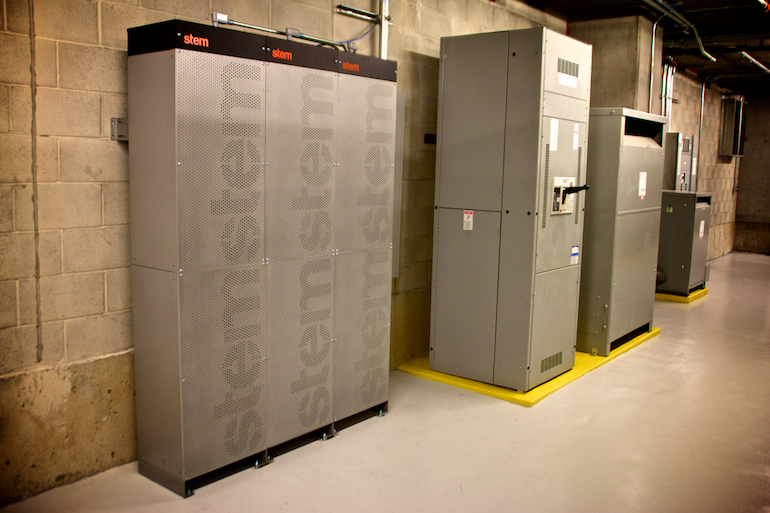Beyond Batteries
Why software is the key to energy storage
 After several fits and starts, and years of debate about its potential to be renewable energy's 'holy grail,' there is now widespread agreement that storage is a crucial component of the modern smart grid. Driven by falling battery costs, new business models and software advancements, utilities and rate-payers are now experiencing the benefits of energy storage. Today, forward-thinking technology providers and grid stakeholders are working together to unlock new revenue streams which surface only when advanced software intelligence is applied to storage hardware.
After several fits and starts, and years of debate about its potential to be renewable energy's 'holy grail,' there is now widespread agreement that storage is a crucial component of the modern smart grid. Driven by falling battery costs, new business models and software advancements, utilities and rate-payers are now experiencing the benefits of energy storage. Today, forward-thinking technology providers and grid stakeholders are working together to unlock new revenue streams which surface only when advanced software intelligence is applied to storage hardware.The strongest case for intelligent energy storage today is being made at the commercial, industrial, and grid levels, where customer-sited systems offer immediate and long-term economic benefits across the board. As noted in the recent Rocky Mountain Institute report, The Economics of Battery Storage, when paired with sophisticated software, customer-sited storage assets can provide as many as 13 services across a variety of stakeholder groups: utilities, grid operators, and electricity users. Some compelling use-cases are highlighted below.
Mitigating demand charges
Commercial and industrial buildings in regions where demand charges are highest have been among the first to experience the benefits of energy storage. In California and New York, demand charges, which are based on 15-minute periods of high demand, can account for as much as 70 percent of businesses' monthly bills. Until now, little could be done to address demand peaks, which are largely impervious to traditional energy efficiency efforts. Hotels, for example, do not have the flexibility to stop running the elevators or turn off air conditioning during peak usage periods.
To combat demand charges without impacting guests' experience, hotel chain Extended Stay America installed intelligent energy storage systems in 68 of its California locations. The intelligent software embedded in the system learns and reacts to energy use to catch all cost-incurring peaks each month. Sophistication of the software is critical, as missing just one peak can erase all value provided by the system earlier in the month. Predicting and reacting to changes in energy usage is a tricky process depending on variable factors such as weather, production ebb and flow, and changing levels of generation from onsite production assets such as solar or fuel cells. Batteries alone cannot effectively predict or quickly react to this variability. They need to be paired with software that's embedded with real customer load and rate data, predictive analytics, real-time weather forecasts, and other feeds.
Opening new revenue streams
Beyond cost savings, commercial and industrial users of intelligent energy storage systems have the opportunity to leverage the battery for grid support, thus opening up an entirely new revenue stream.
Adobe is one of the first companies to demonstrate that commercial energy consumers can support the smart grid with energy storage, and get paid to do it. Adobe's San Francisco Campus participates in the day-ahead and real-time energy markets through the California Independent System Operator (CAISO)'s Supply-Side Pilot. In return for reducing their demand at critical moments for the grid, Adobe earns valuable revenue without expending any effort. The Supply-Side Pilot is a model for similar programs starting to come online across the nation. These programs, which allow businesses to participate directly in electricity markets, will become a core component of tomorrow's smart grid.
Enhancing the value of renewables
Another value stream software brings to energy storage is enhancing generation from onsite renewables. ShoEi Foods, a leader in the food processing industry, invested in a solar PV system as part of its plan to reduce energy spend. This move helped lower ShoEi's electricity usage, but the company captured the greatest value when pairing the solar with storage and software. During times of low solar production, such as on a cloudy day, the battery responds automatically as the first line of defense to reduce demand peaks. At the same time, the software component alerts the building operators of looming peaks so they can reduce usage if they choose. The results have been significant: ShoEi Foods qualified to switch to a lower rate tier, saving the company $72,000 annually.
Restoring balance on the grid
Benefits for utilities that dovetail with end-user benefits include capacity, frequency regulation, renewable integration, voltage support, and enhanced grid visibility. Southern California Edison (SCE), the main electricity supply company for much of Southern California, plans to deploy 135 megawatts of customer-sited energy storage across the West LA Basin to support its local capacity and safeguard its customers from grid instability challenges. With the data it gathers from distributed sites, intelligent storage software can use predictive analytics to identify batteries in its fleet available to provide the grid extra energy when needed. Utilities can save on the costs they would otherwise need to spend on building peaker plants, while also reducing emissions and improving public health and safety.
For utilities, customer-sited intelligent energy storage can also support renewable integration and grid visibility. Hawaiian Electric Company (HECO) contracted to install one megawatt of distributed storage on Oahu to leverage these benefits. Straining under the influx of distributed solar, which causes extremes of high power generation when the sun is shining and lows when it is not, HECO turned to distributed storage to help store and dispatch excess energy when needed. The intelligent software coupled with its battery systems leverages the utility's existing renewable forecasting and monitoring capabilities, providing increased visibility into grid energy patterns and enabling the utility to better predict future energy needs.
Transforming our energy future
More energy users, utilities and grid operators are looking to intelligent energy storage as an invaluable solution. This is evidenced in the recent expansion of utility and ISO programs, including California's Demand Response Auction Mechanism (DRAM), SCE's procurement of energy storage beyond mandated levels, and recent requests for offers for energy storage programs from utilities in New York and Arizona. It's only a matter of time before businesses, municipalities, schools, utilities, and grid operators around the world shift their perception of intelligent energy storage from a "nice-to-have" to a crucial component of daily operations.
 Karen Butterfield is the CCO of Stem, Inc.
Karen Butterfield is the CCO of Stem, Inc.Stem, Inc. | www.stem.com
Volume: 2016 May/June









